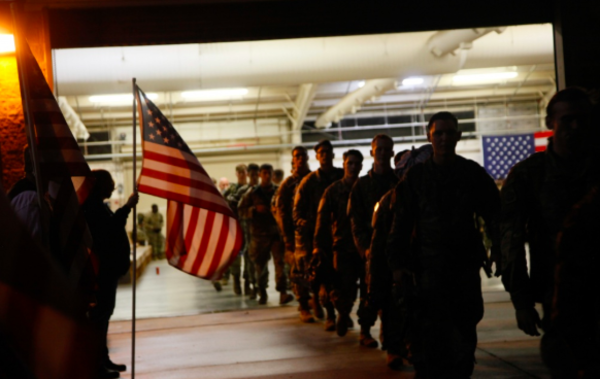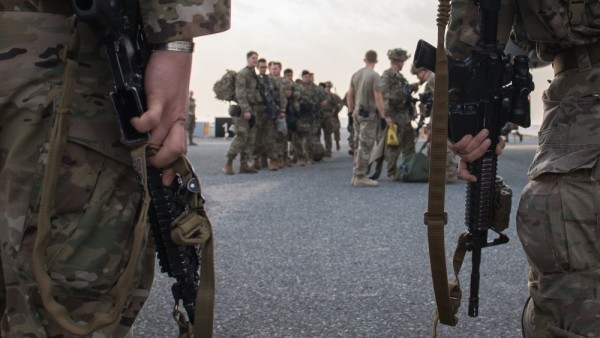Since announcing the deployment of thousands of U.S. troops to Europe in support of NATO allies, there has been little to no information available about what troops are actually doing there. Even some within the military seem confused by the lack of transparency.
“We’re not in Afghanistan, we’re not in this position where there should be such operational oversight of what we’re doing,” a defense official in Europe told Task & Purpose. “It’s kind of stupid that we can’t just be honest about what we’re doing.”
At the beginning of February, service members from the 82nd Airborne Division, 101st Airborne Division, and 18th Airborne Corps headquarters were sent to Europe as a deterrent to Russia, which was massing troops at Ukraine’s border at the time. Other units already in Europe, including an Army infantry battalion task force, a battalion of AH-64 Apache helicopters, and F-35 Joint Strike Fighters were repositioned on the continent. Since Russia’s invasion of Ukraine began, an armored brigade combat team and sustainment brigade within the 3rd Infantry Division were ordered into Europe, and some units, like an armored brigade with the 1st Infantry Division, had their Europe rotation extended to remain in the area.
The Pentagon and White House have been emphatic that those U.S. troops would not be fighting in Ukraine, and instead are there in defense of NATO allies and will be conducting training exercises with military partners.

Subscribe to Task & Purpose Today. Get the latest in military news, entertainment, and gear in your inbox daily.
Military exercises in Europe are typically covered extensively, complete with regular press releases, photos, and videos. Information about troops in Europe today is much more limited.
But this of course is not a routine military exercise; it’s a deployment in the face of what could become “the most devastating conflict on the continent since World War II,” as Vox put it. It’s a war which has already resulted in millions of refugees and hundreds of civilian deaths in Ukraine. And while American service members are preparing for the worst and hundreds of millions of dollars worth of military equipment is being sent to Ukraine, information about what U.S. troops are doing in Europe has been scarce.
The defense official in Europe told Task & Purpose that from “the beginning of the operation” with the 82nd Airborne Division and 18th Airborne Corps specifically, there was “a misunderstanding of who has release authority” on details about what soldiers were doing.
Since then, the official said the 82nd and 18th Airborne Corps have “had to adhere with this very strict messaging embargo kind of thing” which was so difficult to navigate that it got to the point where the units “stopped requesting to even communicate.”

There has been some released information, albeit limited. Photos posted on the Pentagon’s official database for images and videos show soldiers standing with Polish service members, or sitting in a CH-47 Chinook; training on a sniper range, or receiving instruction from a Polish soldier. All of the captions are similar — they provide few details on what is immediately pictured, and simply say that the U.S. military is there to reassure allies and provide support to NATO.
For a quick comparison, a Defense Department news story published this month on U.S. National Guard troops in Kenya included photos, and a lengthy press release with quotes from soldiers participating in the exercise. The same is true for another story, this time from South Korea, which focused on a Patriot Missile Battery. Far from being outliers, the distribution of photo, video, and written stories on what American service members are doing abroad is often the norm for Pentagon press operations and is in line with how the military released information during America’s longest war — until they removed large portions of their archives of Afghanistan coverage. Having some photos is surely better than none at all, but the news packages are often closely reviewed and curated to reinforce the Pentagon’s talking points, and don’t always show the full story. But there’s rarely a shortage of footage.
And while reporters were invited to cover the deployment of troops from Fort Bragg and Fort Stewart, the access essentially ended there. The administration has not allowed media embeds with troops in Europe — something available during past military exercises in Europe — despite requests from the Pentagon Press Association, Military Reporters and Editors Association, with support from the White House Correspondents Association.
“By allowing reporters and photographers to show what life is like for U.S. troops on the ground, in the air, and at sea, the Pentagon will allow the American public to understand the responsibilities and sacrifices that both service members and their families make,” the Military Reporters and Editors letter said.

Asked in early February for a reason behind the denial of media embeds — which were a frequent occurrence throughout the wars in Afghanistan and Iraq, though more often in the early days — Pentagon spokesman John Kirby said “we’re working our way through that right now.” Pressed further by CNN’s Barbara Starr for “one good reason why … the administration will not allow lengthy access for reporters,” Kirby said there were “lots of factors that have gone into this decision.”
The White House did not respond to questions about media access to troops on the ground in Europe.
Entering the fourth week of the invasion, the flow of information — or lack thereof from the Pentagon — hasn’t changed much. One Army commander in Europe told Task & Purpose that they have to get Pentagon approval before posting anything, including photos, on their unit’s official social media sites, something they don’t typically have to do.
While the commander said they understood there’s “not a lot of room for error right now,” they also said it would be better to have “a deliberate information strategy” that allowed the military to be “a part of it at all levels.”

As one Army official who spoke on condition of anonymity pointed out, the U.S. military is “pathologically conservative with messaging,” while “our adversaries have no qualms about [it].”
The defense official in Europe echoed that, saying there seems to be a fear that “any communication could insite additional violence” or push other countries to come to Russia’s aid in its invasion of Ukraine. But given that the deployment of troops to Europe was announced as a deterrent to Russia, the official said it would make sense to communicate that forces like the 82nd Airborne and 18th Airborne Corps were there — especially considering both units’ histories in Europe during World War II.
“Americans … have a right to know what their military is doing,” the official said, “and I don’t think we’re being forthcoming.”
What’s new on Task & Purpose
- A photo apparently showing Russian troops stranded in an elevator is going viral
- A Marine special ops commander explains why Russia’s stalled advance in Ukraine is no surprise
- How the US can beat Russia in Ukraine without firing a shot
- ‘My training took over’ — This Air Force cop went on a 100 mph car chase to arrest suspect
- In search of a just war: Why American veterans are answering a call to serve in Ukraine
Want to write for Task & Purpose? Click here. Or check out the latest stories on our homepage.

























